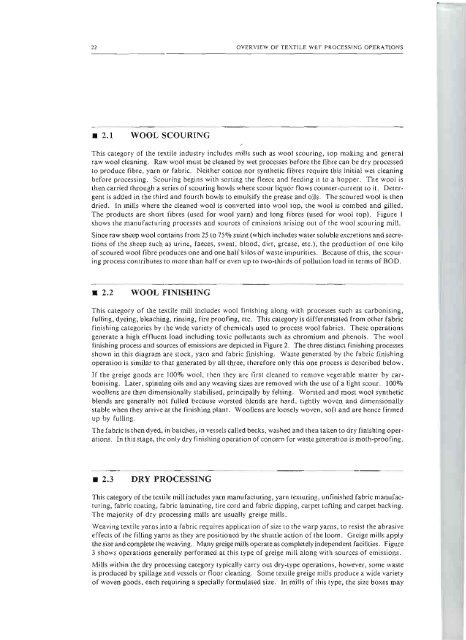Contributor, The Textile Industry and the Environment, UNEP
Contributor, The Textile Industry and the Environment, UNEP
Contributor, The Textile Industry and the Environment, UNEP
Create successful ePaper yourself
Turn your PDF publications into a flip-book with our unique Google optimized e-Paper software.
22 OVERVIEW Of TEXTILE WET PROCESSING OPERATIONS<br />
• 2.1<br />
WOOL SCOURING<br />
This category of <strong>the</strong> textile industry includes mills such as wool scouring, top making <strong>and</strong> general<br />
raw wool cleaning. Raw wool must be cleaned by wet processes before <strong>the</strong> fibre can be dry processed<br />
to produce fibre, yarn or fabric. Nei<strong>the</strong>r cotton nor syn<strong>the</strong>tic fibres require this initial wet cleaning<br />
before processing. Scouring begins with sorting <strong>the</strong> fleece <strong>and</strong> feeding il to a hopper. <strong>The</strong> wool is<br />
<strong>the</strong>n carried through a series of scouring bowls where scour liquor flows counter-current to it. Detergent<br />
is added in <strong>the</strong> third <strong>and</strong> fourth bowls to emulsify <strong>the</strong> grease <strong>and</strong> oils. <strong>The</strong> scoured wool is <strong>the</strong>n<br />
dried. In mills where <strong>the</strong> cleaned wool is converted into wool top, <strong>the</strong> wool is combed <strong>and</strong> gilled.<br />
<strong>The</strong> products are short fibres (used for wool yarn) <strong>and</strong> long fibres (used for wool top). figure 1<br />
shows <strong>the</strong> manufacturing processes <strong>and</strong> sources of emissions arising out of <strong>the</strong> wool scouring mill.<br />
Since raw sheep wool contains from 25 to 75% suint (which includes water soluble excretions <strong>and</strong> secretions<br />
of <strong>the</strong> sheep such as urine, faeces, sweat, blood, dirt, grease, etc.), <strong>the</strong> production of one kilo<br />
of scoured wool fibre produces one <strong>and</strong> one half kilos of waste impurities. Because of this, <strong>the</strong> scouring<br />
process contributes to more than half or even up to two-thirds of pollution load in terms of BOD.<br />
• 2.2<br />
WOOL FINISHING<br />
This category of <strong>the</strong> textile mill includes woo! finishing along with processes such as carbonising,<br />
fulling, dyeing, bleaching, rinsing, fire proofing, etc. This category is differentiated from o<strong>the</strong>r fabric<br />
finishing categories by Ihe wide variety of chemicals used to process wool fabrics. <strong>The</strong>se operations<br />
generate a high effluent load including toxic pollutants such as chromium <strong>and</strong> phenols. <strong>The</strong> wool<br />
finishing process <strong>and</strong> sources of emissions are depicted in Figure 2. <strong>The</strong> three distinct finishing processes<br />
shown in this diagram are stock, yarn <strong>and</strong> fabric finishing. Waste generated by <strong>the</strong> fabric finishing<br />
operation is similar to that generated by all three, <strong>the</strong>refore only this one process is described bclow.<br />
rr <strong>the</strong> greige goods are 1000/0 wool, <strong>the</strong>n <strong>the</strong>y are first cleaned to remove vegetable matter by carbanising.<br />
Later, spinning oils <strong>and</strong> any weaving sizes are removed with <strong>the</strong> use of a light scour. 100070<br />
woollens are <strong>the</strong>n dimensionally stabilised, principally by felting. Worsted <strong>and</strong> most wool syn<strong>the</strong>tic<br />
blends are generally not fulled because worsted blends are hard, tightly woven <strong>and</strong> dimensionally<br />
stable when <strong>the</strong>y arrive at <strong>the</strong> finishing plant. Woollens are loosely woven, soft <strong>and</strong> are hence firmed<br />
up by fuJIing.<br />
<strong>The</strong> fabric is <strong>the</strong>n dyed, in batChes, in vessels called becks, washed <strong>and</strong> <strong>the</strong>n taken to dry finishing operations.<br />
In this stage, <strong>the</strong> only dry finishing operation of concern for waste generation ismotb-proofing.<br />
• 2.3<br />
DRY PROCESSING<br />
This category of <strong>the</strong> textile mill includes yarn manufacturing, yarn texturing, unfinished fabric manufacturing,<br />
fabric coating, fabric laminating, tire cord <strong>and</strong> fabric dipping, carpet tufting <strong>and</strong> carpet backing.<br />
<strong>The</strong> majority of dry processing mills are usually greige mills.<br />
Weaving textile yarns into a fabric requires appljcatioo of size to <strong>the</strong> warp yarns, to resist <strong>the</strong> abrasive<br />
effects of <strong>the</strong> filling yarns as <strong>the</strong>y are positioned by <strong>the</strong> shuttle action of <strong>the</strong> loom. Greige mills apply<br />
tbe size <strong>and</strong> complete <strong>the</strong> weaving. Many greige mills operate as completely independent facilities. figure<br />
3 shows operations generally performed at this type of greige mill along with sources of emissions.<br />
Mills within <strong>the</strong> dry processing category lypically carry out dry-type operations, however, some waste<br />
is produced by spillage <strong>and</strong> vessels or floor cleaning. Some textile greige mills produce a wide variety<br />
of woven goods, each requiring a specially formulated size. In mills of Ihis type, tne size boxes may

















